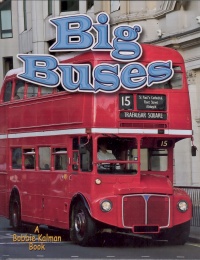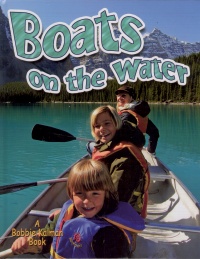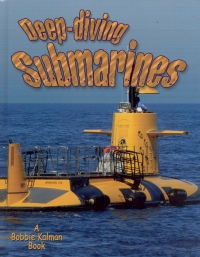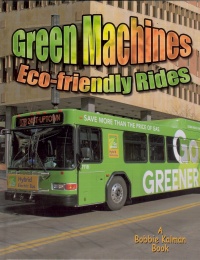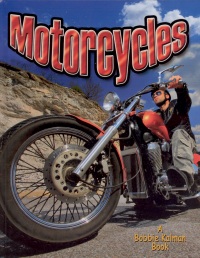| ________________
CM . . . . Volume XVII Number 37 . . . . May 27, 2011
excerpt:
Part of the 16-volume "Vehicles on the Move" series, these books provide simple explanations, appropriate to the target audience, about how different vehicles work. Within each category of vehicle, there are many variants, and these are showcased in double-page spreads. The inclusion of some very unusual and seldom seen vehicles is sure to appeal. There are two paragraphs describing each type of vehicle, and plenty of colour photographs and diagrams to enhance the text. Boys, especially, will be drawn to this series of books. A table of contents, a small "words to know" section, and an index are provided. Bicycles describes a large number of bikes and explains the differences among them- their appearance, specialized parts or accessories, and their purpose. Mountain, stunt (BMX), racing and tandem bikes might be familiar to readers, but party bikes that are designed for up to seven people, or conference bikes, in which the riders sit in a circle, are quite unique and will pique the reader's interest. Other bicycles mentioned are unicycles, recumbent bikes, handcycles for increasing upper body strength, and electric bikes that are powered by batteries. The many work-related uses of bicycles are also discussed, some examples being taxis (rickshaws), the delivery of goods by courier, and their use in law enforcement so that police officers can get to places where cars cannot. Some of the vehicles described in Buses might not seem to fit into the category at first glance. By definition, buses are "vehicles that move many people." In that case, subway trains, trolleys, streetcars and cable cars are considered buses. This book covers a variety of other buses as well- public transit buses, paratransit for people with special needs, articulated buses (those that bend in the middle at a joint), school, coach and touring buses and double-deckers. It is estimated that a single busload of people is the equivalent of 40 drivers of automobiles, thereby making the decision to take a bus a more environmentally friendly choice. Incidentally, San Francisco is the only North American city that still has cable cars in service. Boats on the Water features vehicles that float. These come in different sizes and are designed for specific purposes. Some hold one person, while others hold thousands. This title explains the parts of a boat, the materials used, and the various ways that boats can move on water. Types of boats range from cruising and racing yachts to catamarans and kayaks. The more unique types showcased include airboats, which have an above-water propeller inside a metal cage and are suitable for travelling through swamps, such as the Florida Everglades, and hydrofoils and hovercrafts, the latter able to travel on water, land and ice. Hovercrafts are primarily used by the military to carry vehicles and personnel from ship to shore. Travelling underwater and under thick ice, submarines are used by the military and for research. The fastest can go more than 75 kilometres per hour, while the smallest can go more than 9,000 metres below the surface. In Deep-diving Submarines, readers will learn about periscopes, nuclear versus diesel-electric power, and passive versus active sonar systems. Other topics include submersibles, which are smaller versions of research subs that can explore smaller areas of the ocean floor, and robotic arms that can pick up samples, allowing scientists to study overfishing, pollution and marine animals, and to check for oil leaks and chemical spills from ships. Some particularly interesting facts found in this title are that a submersible, named Alvin, found the remains of the Titanic, and that a typhoon-class sub, used by the Russian military, is 170 metres long, can stay submerged for 120 days at a time, has 150 crew members, and even has a swimming pool. Green machines are vehicles that carry people and goods, but they are more environmentally-friendly than regular cars. Topics in Green Machines: Eco-friendly Rides include a comparison of non-renewable and renewable resources, global warming and its relation to fossil fuels, and the advantages of micro cars, flex-fuel vehicles and ethanol fuel, which is made from plants such as corn and potatoes. Hybrids, electric and solar vehicles, tri-cars (lightweight and fuel-efficient 3-wheeled cars used by the NYPD), bicycles, scooters, mopeds, velomobiles (covered bikes) and segways are also covered in this title. Motorcycles explains the different types of motorbikes and their purposes. Some examples include touring or cruising bikes which are designed for long highway trips, the smaller and lighter racing bikes which have a streamlined shape, choppers, scooters, off road, motocross, and stunt bikes, the earliest forms of which were known as "boneshakers" because the riders were shook up from driving on bumpy country roads. Special safety gear ( helmet, leather gloves, boots, pants and jackets) is also discussed. A double-page spread features the Harley-Davidson Motor Company, founded in 1908. Because motorcycles built by this company are known for their powerful engines and reliability, they are used by 3,000 police departments in the United States and in 45 other countries. Providing interesting facts about unique vehicles, this series is bound to be very popular with boys. Recommended. Gail Hamilton is Library Learning Resources Consultant at the Instructional Resources Unit, Manitoba Department of Education, in Winnipeg, MB.
To comment
on this title or this review, send mail to cm@umanitoba.ca.
Copyright © the Manitoba Library Association. Reproduction for personal
use is permitted only if this copyright notice is maintained. Any
other reproduction is prohibited without permission.
NEXT REVIEW |
TABLE OF CONTENTS FOR THIS ISSUE
- May 27, 2011.
AUTHORS |
TITLES |
MEDIA REVIEWS |
PROFILES |
BACK ISSUES |
SEARCH |
CMARCHIVE |
HOME |

